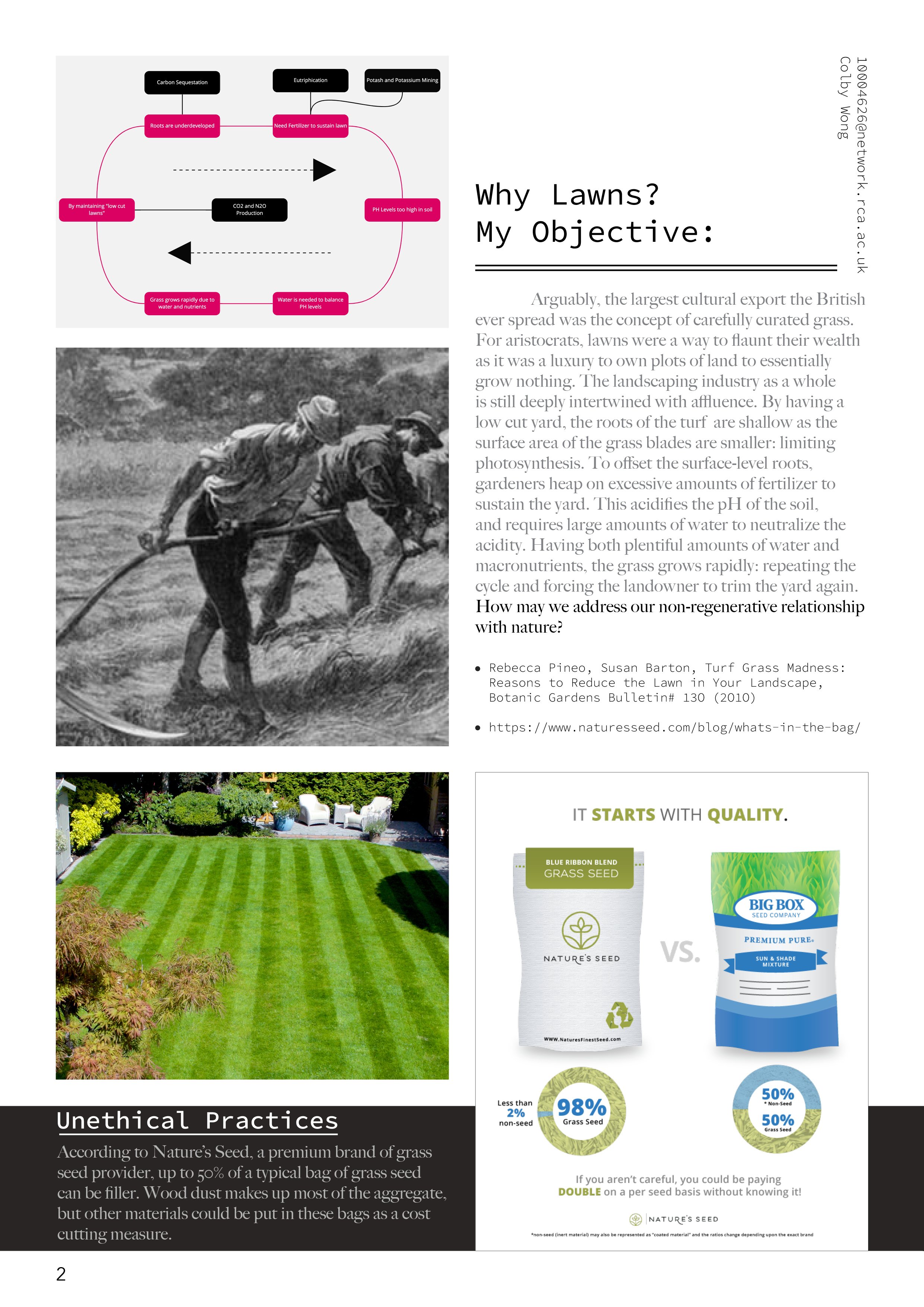Carbon Sequestration through Pollinating London
While researching the unsustainable practices of lawn keeping, I had found a direct correlation between the amount of biodiversity in a given area and the quantity of carbon sequestered. Through analyzing the various ways of introducing greenery into municipal spaces, I designed two proposals that aim to bolster pollination city-wide at both social and personal levels.
Proposal 1:
By utilizing the tessellating form of tetrahedrons, I created a module designed to be installed in London’s open spaces, so that people and fauna can inhabit green spaces that could not exist otherwise.
Proposal 2:
Identifying London’s bus network as a potential way to pollinate the city, I proposed a series of green roofs to allow pollinators to take advantage of human infrastructure, by “piggybacking” off of transportation.
Project duration: 3 Months
Key Skills:
Full Document:
Who are we designing for?
When tackling a complex system such as increasing biodiversity within London, designers must consider who and what they hope to engage to facilitate the intended experience or goal. It is easy to only consider the people within an ecosystem, but to increase inner city pollination, flora and fauna must be catered for as well.
What are “pests”?
Pigeons and weeds are commonly seen as “pests” by the many, however these organisms thrive in the urban landscape for a reason: both pigeons and weeds are hardy and adaptable. To promote pollination within London, how may we leverage the strengths of these entities while mitigating their negative traits?
Visiting Sites
To understand the current ecosystems in London’s cityscape, I began visiting various green spaces and common areas. From conducting on-site research, I learned that even if non-permeable areas of London were turned into green spaces, due to the degradation of the soil underneath, nothing would be able to thrive.
Bees are not the only pollinators…
Contrary to popular belief, bees are not the only pollinating creatures in the wild. Birds, bats, butterflies, moths, flies, beetles, wasps, squirrels, possums, and many more serve to spread the pollen of different species of plants. To improve pollination, we need to help London’s pollinators more comfortable.
Unappreciated heroes
Studies have shown that fostering “monocultures” (the practice of only growing one type of plant) leads to: loss of biodiversity, increased water and fertilizer consumption, and soil degradation. Weeds, can be a powerful tool to combat our wasteful practices of curated green spaces within London.
Modular rewinding structures
To help facilitate the roles that inner city pollinators conduct, I created a modular system of tessellating units that can be assembled to quickly and easily form green structures for humans and animals to walk through and engage with. I chose to make my system modular, as different locations have different amounts of available space, which a modular system can inhabit according to the needs of the location.
Three prototypes were designed to show how the structure would function. One module is designed to have a series of pockets filled with seeds from weeds and growth aggregate, where another unit is a shelter for birds and squirrels to take shelter in.
My thoughts on the tetrahedrons
Some of the main feedback I received from critics were that people found it hard to imagine how a structure of these different forms could be assembled. Here, I learned that in order to illustrate the feasibility of my idea, perhaps more testing is needed.
All in all, I thought these modules were quite successful in garnering attention and interest for my project. However, the question of maintenance of these objects was called into question. If the city of London were to adopt and deploy these modules, what existing infrastructure could they employ in order to keep maintenance at a minimum?
Seeking Inspiration
While learning about plants, I was fascinated by the way that coconuts utilized the water currents of their tropical climates to propagate themselves to new territories. With pollination in mind, what could I utilize to help weeds spread and capture carbon across London?
London’s Arteries
Within the city, buses are frequently seen departing from terminals and stopping at bus stops along routes. As a designer, how could I rethink public transport as urban pollination machines?
Mapping the Experience
By interviewing TFL and various bus companies regarding the everyday operations of their vehicles, I mapped how buses could utilize proven green roof modules to pollinate along their routes. By using “off-the-shelf” parts, not only can maintenance and initial costs be kept low, but these systems have been proven to work.
Evaluating feasibility
With the idea, I looked at what other designers had created and how successful various design interventions were. By evaluating what products and services already exist, I could better position my work “in situ”.
Prototyping in CAD
After evaluating what stakeholders and pollinating products already existed, I created designs through CAD. After sketching iterations of altered bus stops and vehicle green roofs, I used 3D printing to help others visualize how the system would manifest.
Conclusion
In this project, I have created two distinct proposals that aim to improve pollination within London. The tessellating tetrahedrons aim to create green spaces at a product/ personal level, and my pollinating bus prototypes try to increase biodiversity at a system/ municipal level.
Icons by several authors, all rights to perspective owners






































